FORD MUSTANG 1969 Volume One Chassis
Manufacturer: FORD, Model Year: 1969, Model line: MUSTANG, Model: FORD MUSTANG 1969Pages: 413, PDF Size: 75.81 MB
Page 301 of 413
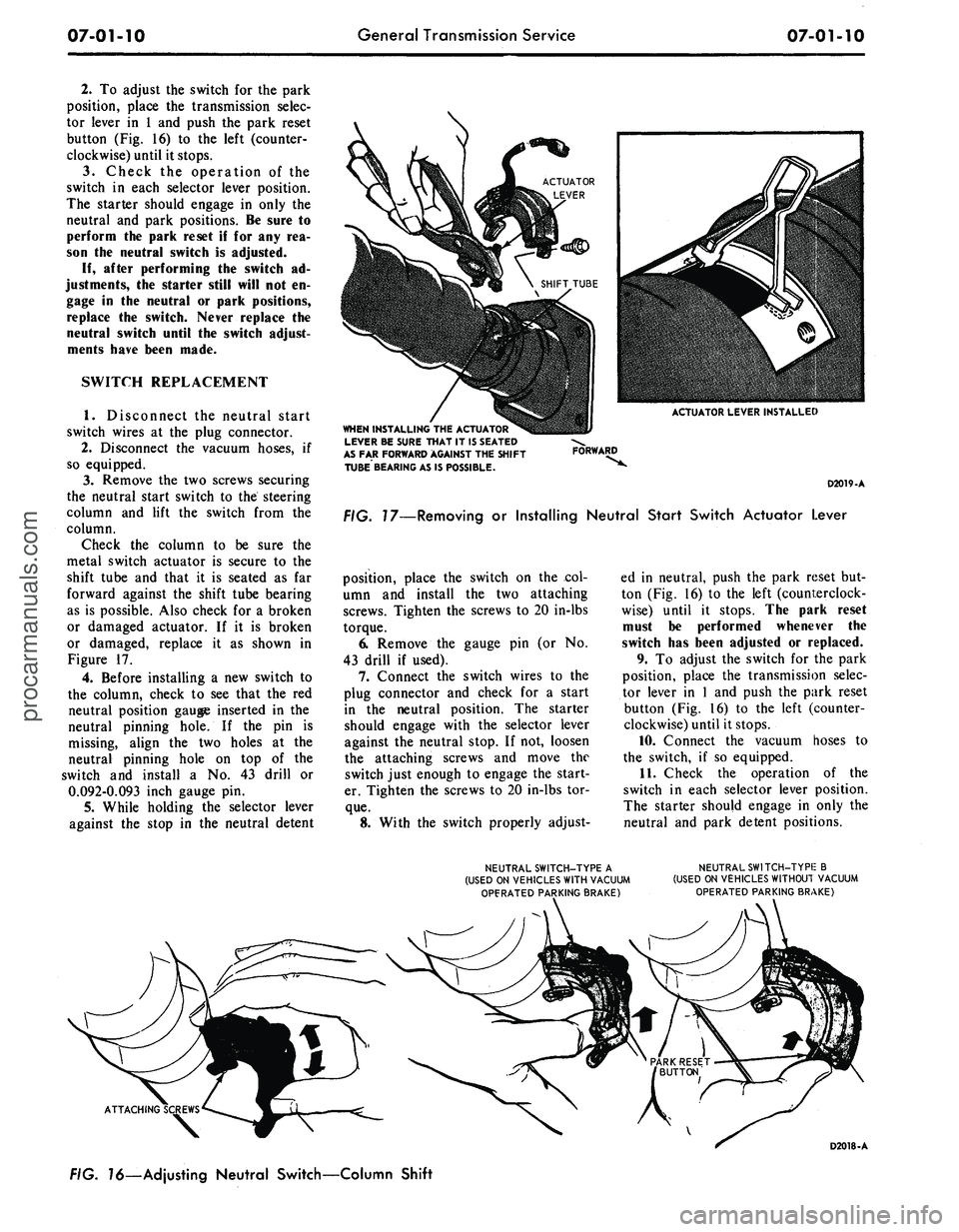
07-01-10
General Transmission Service
07-01-10
2.
To adjust the switch for the park
position, place the transmission selec-
tor lever in 1 and push the park reset
button (Fig. 16) to the left (counter-
clockwise) until it stops.
3.
Check the operation of the
switch in each selector lever position.
The starter should engage in only the
neutral and park positions. Be sure to
perform
the
park reset
if for any rea-
son
the
neutral switch
is
adjusted.
If,
after performing
the
switch
ad-
justments,
the
starter still will
not en-
gage
in the
neutral
or
park positions,
replace
the
switch. Never replace
the
neutral switch until
the
switch adjust-
ments have been made.
SWITCH REPLACEMENT
1.
Disconnect the neutral start
switch wires at the plug connector.
2.
Disconnect the vacuum hoses, if
so equipped.
3.
Remove the two screws securing
the neutral start switch to the steering
column and lift the switch from the
column.
Check the column to be sure the
metal switch actuator is secure to the
shift tube and that it is seated as far
forward against the shift tube bearing
as is possible. Also check for a broken
or damaged actuator. If it is broken
or damaged, replace it as shown in
Figure 17.
4.
Before installing a new switch to
the column, check to see that the red
neutral position gauge inserted in the
neutral pinning hole. If the pin is
missing, align the two holes at the
neutral pinning hole on top of the
switch and install a No. 43 drill or
0.092-0.093 inch gauge pin.
5.
While holding the selector lever
against the stop in the neutral detent
ACTUATOR LEVER INSTALLED
WHEN INSTALLING
THE
ACTUATOR
LEVER
BE
SURE THAT
IT
1$ SEATED
AS
FAR
FORWARD AGAINST
THE
SHIFT
TUBE BEARING
AS IS
POSSIBLE.
FORWARD
D2019-A
FIG. 17—Removing
or
Installing Neutral Start Switch Actuator Lever
position, place the switch on the col-
umn and install the two attaching
screws. Tighten the screws to 20 in-lbs
torque.
6. Remove the gauge pin (or No.
43 drill if used).
7.
Connect the switch wires to the
plug connector and check for a start
in the neutral position. The starter
should engage with the selector lever
against the neutral stop. If not, loosen
the attaching screws and move the
switch just enough to engage the start-
er. Tighten the screws to 20 in-lbs tor-
que.
8. With the switch properly adjust-
ed in neutral, push the park reset but-
ton (Fig. 16) to the left (counterclock-
wise) until it stops. The park reset
must be performed whenever the
switch has been adjusted or replaced.
9. To adjust the switch for the park
position, place the transmission selec-
tor lever in 1 and push the park reset
button (Fig. 16) to the left (counter-
clockwise) until it stops.
10.
Connect the vacuum hoses to
the switch, if so equipped.
11.
Check the operation of the
switch in each selector lever position.
The starter should engage in only the
neutral and park detent positions.
NEUTRAL SWITCH-TYPE
A
(USED
ON
VEHICLES WITH VACUUM
OPFRATED PARKING BRAKE)
NEUTRAL SWITCH-TYPIE
B
(USED
ON
VEHICLES WITHOUT VACUUM
OPERATED PARKING BRAKE)
ATTACHING
FIG.
16—Ad
justing Neutral Switch—Column Shift
D2018-Aprocarmanuals.com
Page 302 of 413
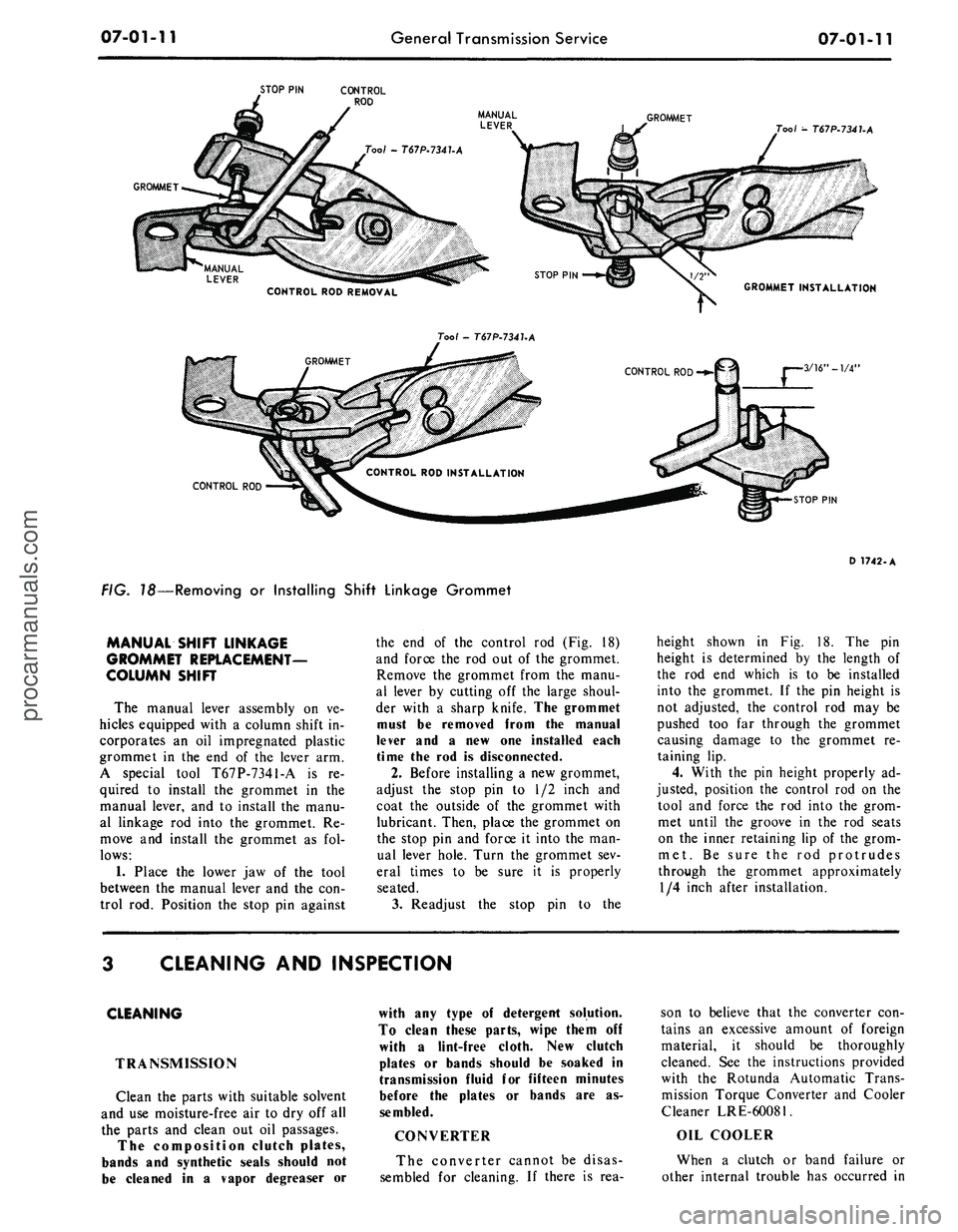
07-01-11
General Transmission Service
07-01-11
STOP
PIN
GROMMET
Tool - T67P-734LA
GROMMET
LEVER
CONTROL ROD REMOVAL
GROMMET INSTALLATION
Tool - T67P-734LA
r
CONTROL ROD INSTALLATION
3/16"-1/4'
CONTROL ROD
STOP
PIN
FIG. 18—Removing
or
Installing Shift Linkage Grommet
D 1742-A
MANUAL SHIFT LINKAGE
GROMMET REPLACEMENT-
COLUMN SHIFT
The manual lever assembly
on ve-
hicles equipped with
a
column shift
in-
corporates
an oil
impregnated plastic
grommet
in the end of the
lever
arm.
A special tool T67P-7341-A
is re-
quired
to
install
the
grommet
in the
manual lever,
and to
install
the
manu-
al linkage
rod
into
the
grommet.
Re-
move
and
install
the
grommet
as fol-
lows:
1.
Place
the
lower
jaw of the
tool
between
the
manual lever
and the con-
trol
rod.
Position
the
stop
pin
against
the
end of the
control
rod (Fig. 18)
and force
the rod out of the
grommet.
Remove
the
grommet from
the
manu-
al lever
by
cutting
off the
large shoul-
der with
a
sharp knife.
The
grommet
must
be
removed from
the
manual
lever
and a new one
installed each
time
the rod is
disconnected.
2.
Before installing
a
new grommet,
adjust
the
stop
pin to 1/2
inch
and
coat
the
outside
of the
grommet with
lubricant. Then, place
the
grommet
on
the stop
pin and
force
it
into
the
man-
ual lever hole. Turn
the
grommet
sev-
eral times
to be
sure
it is
properly
seated.
3.
Readjust
the
stop
pin to the
height shown
in Fig. 18. The pin
height
is
determined
by the
length
of
the
rod end
which
is to be
installed
into
the
grommet.
If the pin
height
is
not adjusted,
the
control
rod may be
pushed
too far
through
the
grommet
causing damage
to the
grommet
re-
taining
lip.
4.
With
the pin
height properly
ad-
justed, position
the
control
rod on the
tool
and
force
the rod
into
the
grom-
met until
the
groove
in the rod
seats
on
the
inner retaining
lip of the
grom-
met.
Be
sure
the rod
protrudes
through
the
grommet approximately
1/4 inch after installation.
CLEANING
AND
INSPECTION
CLEANING
TRANSMISSION
Clean
the
parts with suitable solvent
and
use
moisture-free
air to dry off all
the parts
and
clean
out oil
passages.
The composition clutch plates,
bands
and
synthetic seals should
not
be cleaned
in a
vapor degreaser
or
with
any
type
of
detergent solution.
To clean these parts, wipe them
off
with
a
lint-free cloth.
New
clutch
plates
or
bands should
be
soaked
in
transmission fluid
for
fifteen minutes
before
the
plates
or
bands
are as-
sembled.
CONVERTER
The converter cannot
be
disas-
sembled
for
cleaning.
If
there
is rea-
son
to
believe that
the
converter
con-
tains
an
excessive amount
of
foreign
material,
it
should
be
thoroughly
cleaned.
See the
instructions provided
with
the
Rotunda Automatic Trans-
mission Torque Converter
and
Cooler
Cleaner LRE-60081.
OIL COOLER
When
a
clutch
or
band failure
or
other internal trouble
has
occurred
inprocarmanuals.com
Page 303 of 413
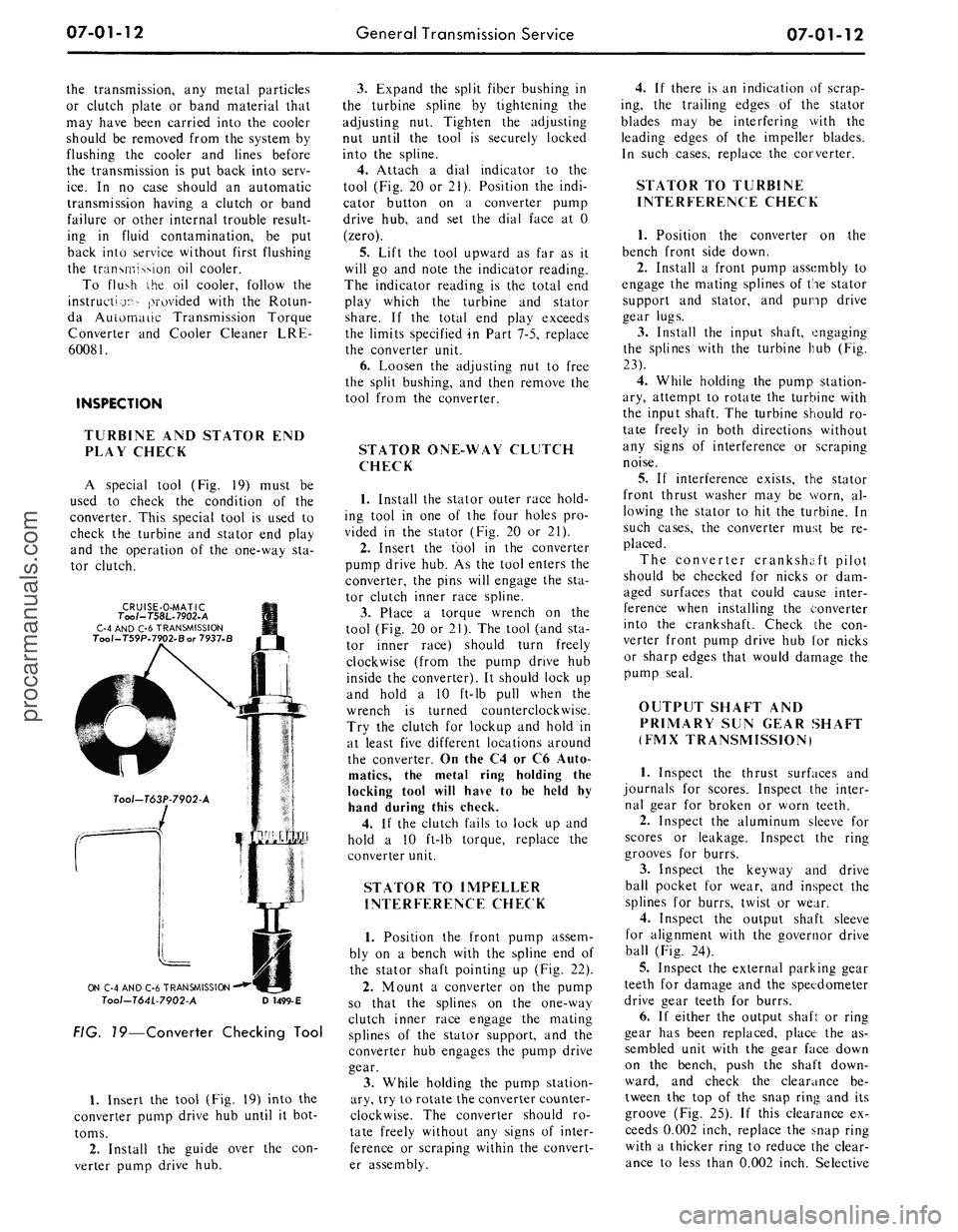
07-01-12
General Transmission Service
07-01-12
the transmission,
any
metal particles
or clutch plate
or
band material that
may have been carried into
the
cooler
should
be
removed from
the
system
by
flushing
the
cooler
and
lines before
the transmission
is put
back into serv-
ice.
In no
case should
an
automatic
transmission having
a
clutch
or
band
failure
or
other internal trouble result-
ing
in
fluid contamination,
be put
back into service without first flushing
the transmission
oil
cooler.
To flush
the oil
cooler, follow
the
instruct!
on >
provided with
the
Rotun-
da Automatic Transmission Torque
Converter
and
Cooler Cleaner
LRE-
60081.
INSPECTION
TURBINE
AND
STATOR
END
PLAY CHECK
A special tool
(Fig. 19)
must
be
used
to
check
the
condition
of the
converter. This special tool
is
used
to
check
the
turbine
and
stator
end
play
and
the
operation
of the
one-way
sta-
tor clutch.
CRUISE-O-MATIC
Too/-T58L-7902-A
C-4 AND C-6 TRANSMISSION
Tool-T59P.7902.Bor 7937-B
ON C-4 AND C-6 TRANSMISSION
Tool-T64L-7902-A
D
1499-E
FIG. 19—Converter Checking Tool
1.
Insert
the
tool (Fig.
19)
into
the
converter pump drive
hub
until
it
bot-
toms.
2.
Install
the
guide over
the con-
verter pump drive
hub.
3.
Expand
the
split fiber bushing
in
the turbine spline
by
tightening
the
adjusting
nut.
Tighten
the
adjusting
nut until
the
tool
is
securely locked
into
the
spline.
4.
Attach
a
dial indicator
to the
tool (Fig.
20 or
21). Position
the
indi-
cator button
on a
converter pump
drive
hub, and set the
dial face
at 0
(zero).
5.
Lift
the
tool upward
as far as it
will
go and
note
the
indicator reading.
The indicator reading
is the
total
end
play which
the
turbine
and
stator
share.
If the
total
end
play exceeds
the limits specified
in
Part 7-5, replace
the converter unit.
6. Loosen
the
adjusting
nut to
free
the split bushing,
and
then remove
the
tool from
the
converter.
STATOR ONE-WAY CLUTCH
CHECK
1.
Install
the
stator outer race hold-
ing tool
in one of the
four holes
pro-
vided
in the
stator (Fig.
20 or 21).
2.
Insert
the
tool
in the
converter
pump drive hub.
As the
tool enters
the
converter,
the
pins will engage
the sta-
tor clutch inner race spline.
3.
Place
a
torque wrench
on the
tool (Fig.
20 or
21).
The
tool (and
sta-
tor inner race) should turn freely
clockwise (from
the
pump drive
hub
inside
the
converter).
It
should lock
up
and hold
a 10
ft-lb pull when
the
wrench
is
turned counterclockwise.
Try
the
clutch
for
lockup
and
hold
in
at least five different locations around
the converter.
On
the
C4
or C6
Auto-
matics,
the
metal ring holding
the
locking tool will have
to be
held
by
hand during this check.
4.
If the
clutch fails
to
lock
up and
hold
a 10
ft-lb torque, replace
the
converter unit.
STATOR
TO
IMPELLER
INTERFERENCE CHECK
1.
Position
the
front pump assem-
bly
on a
bench with
the
spline
end of
the stator shaft pointing
up
(Fig.
22).
2.
Mount
a
converter
on the
pump
so that
the
splines
on the
one-way
clutch inner race engage
the
mating
splines
of the
stator support,
and the
converter
hub
engages
the
pump drive
gear.
3.
While holding
the
pump station-
ary, try
to
rotate the converter counter-
clockwise.
The
converter should
ro-
tate freely without
any
signs
of
inter-
ference
or
scraping within
the
convert-
er assembly.
4.
If
there
is an
indication
of
scrap-
ing,
the
trailing edges
of the
stator
blades
may be
interfering with
the
leading edges
of the
impeller blades.
In such cases, replace
the
converter.
STATOR
TO
TURBINE
INTERFERENCE CHECK
1.
Position
the
converter
on the
bench front side down.
2.
Install
a
front pump assembly
to
engage
the
mating splines
of
the
stator
support
and
stator,
and
pump drive
gear lugs.
3.
Install
the
input shaft, engaging
the splines with
the
turbine
hub (Fig.
23).
4.
While holding
the
pump station-
ary, attempt
to
rotate
the
turbine with
the input shaft.
The
turbine should
ro-
tate freely
in
both directions without
any signs
of
interference
or
scraping
noise.
5.
If
interference exists,
the
stator
front thrust washer
may be
worn,
al-
lowing
the
stator
to hit the
turbine.
In
such cases,
the
converter must
be re-
placed.
The converter crankshaft pilot
should
be
checked
for
nicks
or dam-
aged surfaces that could cause inter-
ference when installing
the
converter
into
the
crankshaft. Check
the con-
verter front pump drive
hub for
nicks
or sharp edges that would damage
the
pump seal.
OUTPUT SHAFT
AND
PRIMARY
SUN
GEAR SHAFT
(FMX TRANSMISSION)
1.
Inspect
the
thrust surfaces
and
journals
for
scores. Inspect
the
inter-
nal gear
for
broken
or
worn teeth.
2.
Inspect
the
aluminum sleeve
for
scores
or
leakage. Inspect
the
ring
grooves
for
burrs.
3.
Inspect
the
keyway
and
drive
ball pocket
for
wear,
and
inspect
the
splines
for
burrs, twist
or
wear.
4.
Inspect
the
output shaft sleeve
for alignment with
the
governor drive
ball (Fig.
24).
5.
Inspect
the
external parking gear
teeth
for
damage
and the
speedometer
drive gear teeth
for
burrs.
6.
If
either
the
output shaft
or
ring
gear
has
been replaced, place
the as-
sembled unit with
the
gear face down
on
the
bench, push
the
shaft down-
ward,
and
check
the
clearance
be-
tween
the top of the
snap ring
and its
groove
(Fig. 25).
If
this clearance
ex-
ceeds 0.002 inch, replace
the
snap ring
with
a
thicker ring
to
reduce
the
clear-
ance
to
less than 0.002 inch. Selectiveprocarmanuals.com
Page 304 of 413
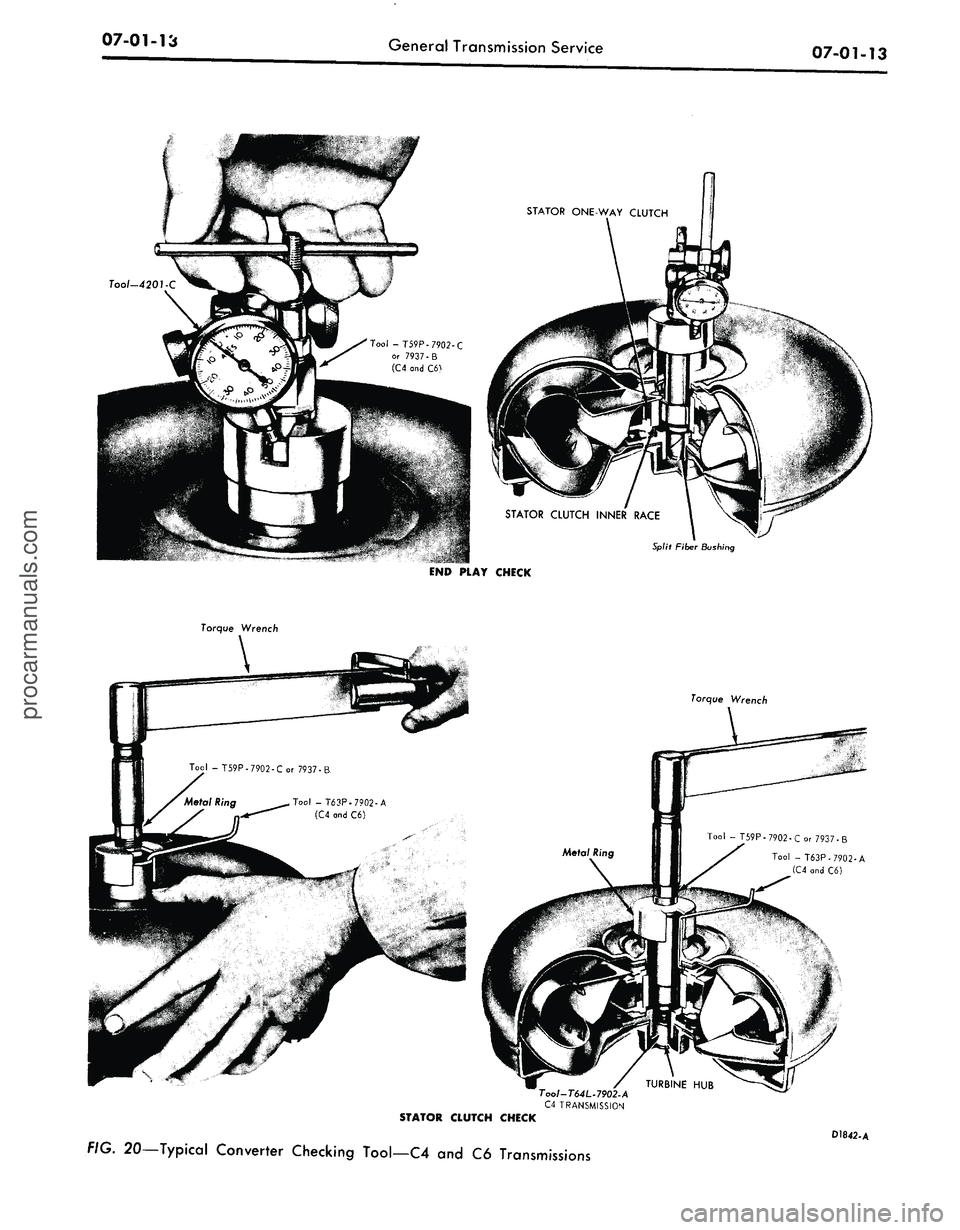
07-01-13
General Transmission Service
Tool -T59P-7902-C
or 7937-
(C4
and
C6)
STATOR CLUTCH INNER RACE
Split Fiber Bushing
END PLAY CHECK
Torque Wrench
Torque Wrench
Tool-T64L.790~2-A
C4 TRANSMISSION
STATOR CLUTCH CHECK
FIG. 20—Typical Converter Checking Tool—C4
and C6
Transmissions
D1842-Aprocarmanuals.com
Page 305 of 413
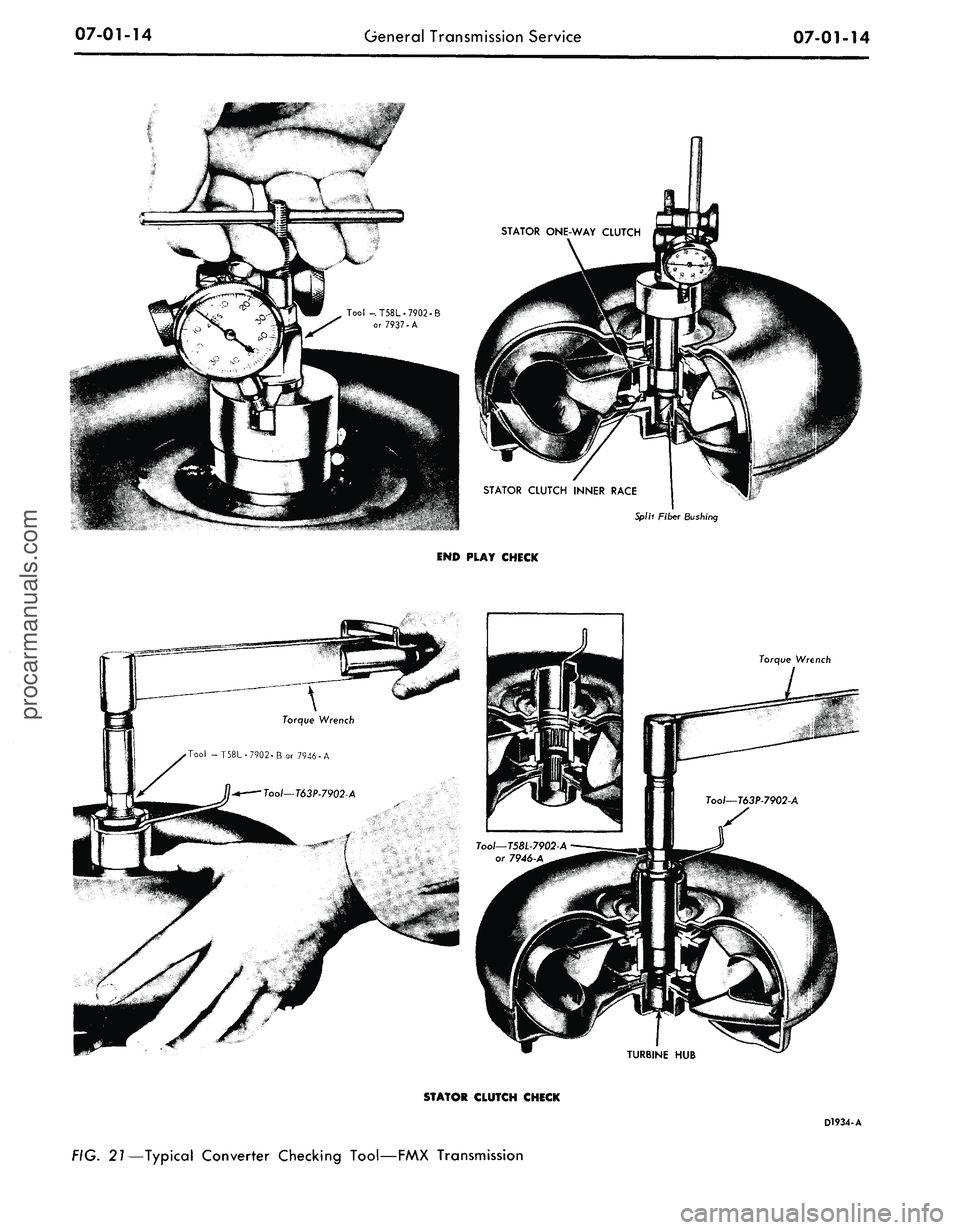
07-01-14
General Transmission Service
07-01-14
STATOR CLUTCH INNER RACE
Splh Fiber Bushing
END PLAY CHECK
Torque
Wrench
Torque
Wrench
Tool -T58L-7902-B or 7946-A
TURBINE HUB
STATOR CLUTCH CHECK
D1934-A
FIG. 21—Typical Converter Checking Tool—FMX Transmissionprocarmanuals.com
Page 306 of 413
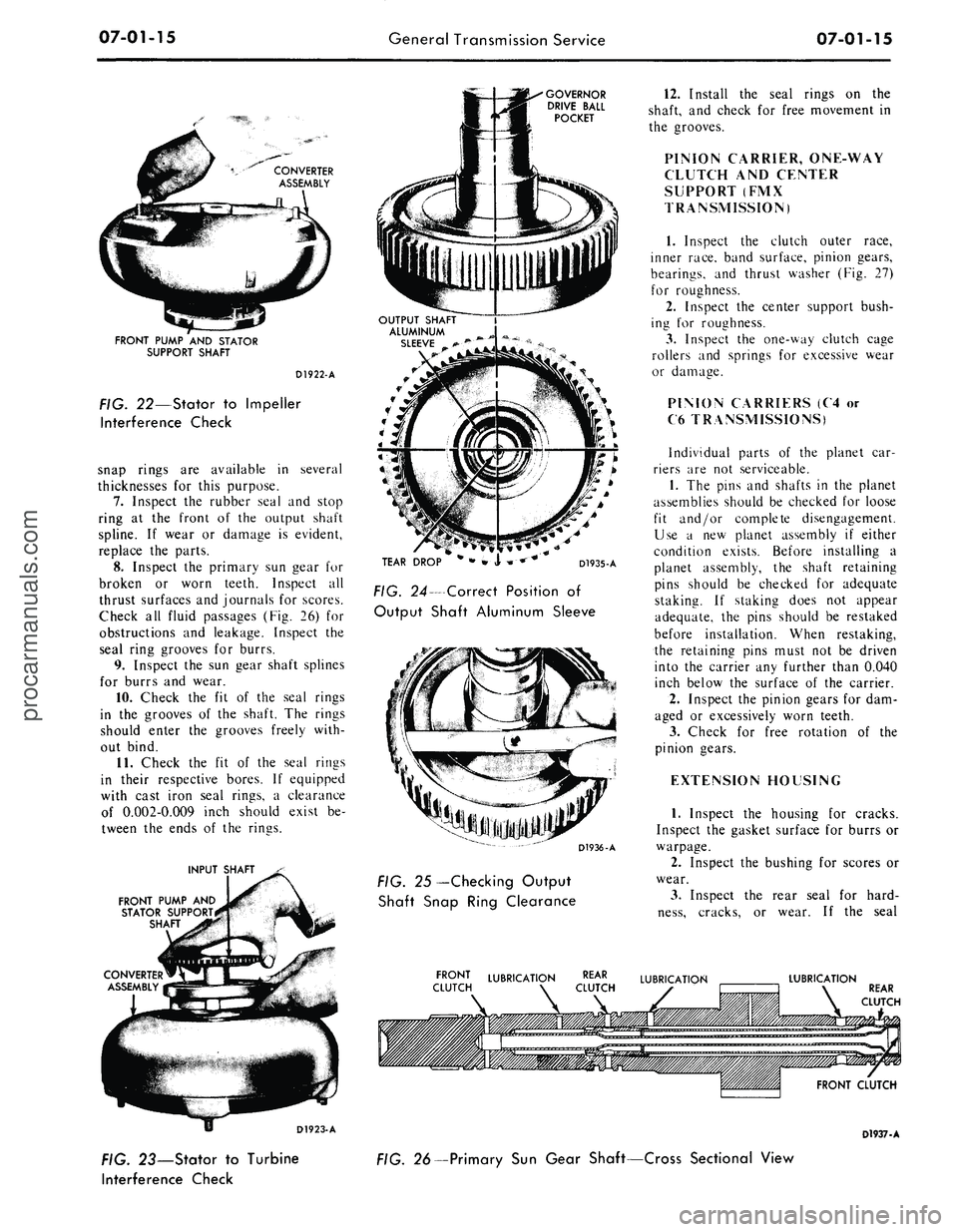
07-01-15
General Transmission Service
07-01-15
GOVERNOR
DRIVE BALL
POCKET
FRONT PUMP AND STATOR
SUPPORT SHAFT
D1922-A
FIG. 22—Stator to Impeller
Interference Check
snap rings are available in several
thicknesses for this purpose.
7.
Inspect the rubber seal and stop
ring at the front of the output shaft
spline. If wear or damage is evident,
replace the parts.
8. Inspect the primary sun gear for
broken or worn teeth. Inspect all
thrust surfaces and journals for scores.
Check all fluid passages (Fig. 26) for
obstructions and leakage. Inspect the
seal ring grooves for burrs.
9. Inspect the sun gear shaft splines
for burrs and wear.
10.
Check the fit of the seal rings
in the grooves of the shaft. The rings
should enter the grooves freely with-
out bind.
11.
Check the fit of the seal rings
in their respective bores. If equipped
with cast iron seal rings, a clearance
of 0.002-0.009 inch should exist be-
tween the ends of the rings.
INPUT SHAFT
FRONT PUMP AND
STATOR SUPPORT
SHAFT
CONVERTER
ASSEMBLY
D1923-A
TEAR DROP
D1935-A
FIG. 24—Correct Position of
Output Shaft Aluminum Sleeve
D1936-A
FIG. 25—Checking Output
Shaft Snap Ring Clearance
12.
Install the seal rings on the
shaft, and check for free movement in
the grooves.
PINION CARRIER, ONE-WAY
CLUTCH AND CENTER
SUPPORT (FMX
TRANSMISSION)
1.
Inspect the clutch outer race,
inner race, band surface, pinion gears,
bearings, and thrust washer (Fig. 27)
for roughness.
2.
Inspect the center support bush-
ing for roughness.
3.
Inspect the one-way clutch cage
rollers and springs for excessive wear
or damage.
PINION CARRIERS (C4 or
C6 TRANSMISSIONS)
Individual parts of the planet car-
riers are not serviceable.
1.
The pins and shafts in the planet
assemblies should be checked for loose
fit and/or complete disengagement.
Use a new planet assembly if either
condition exists. Before installing a
planet assembly, the shaft retaining
pins should be checked for adequate
staking. If staking does not appear
adequate, the pins should be restaked
before installation. When restaking,
the retaining pins must not be driven
into the carrier any further than 0.040
inch below the surface of the carrier.
2.
Inspect the pinion gears for dam-
aged or excessively worn teeth.
3.
Check for free rotation of the
pinion gears.
EXTENSION HOUSING
1.
Inspect the housing for cracks.
Inspect the gasket surface for burrs or
warpage.
2.
Inspect the bushing for scores or
wear.
3.
Inspect the rear seal for hard-
ness,
cracks, or wear. If the seal
FRONT LUBRICATION REAR LUBRICATION
CLUTCH \ CLUTCH
LUBRICATION
FRONT CLUTCH
D1937-A
FIG. 23—Stator to Turbine
Interference Check
FIG. 26—Primary Sun Gear Shaft—Cross Sectional Viewprocarmanuals.com
Page 307 of 413
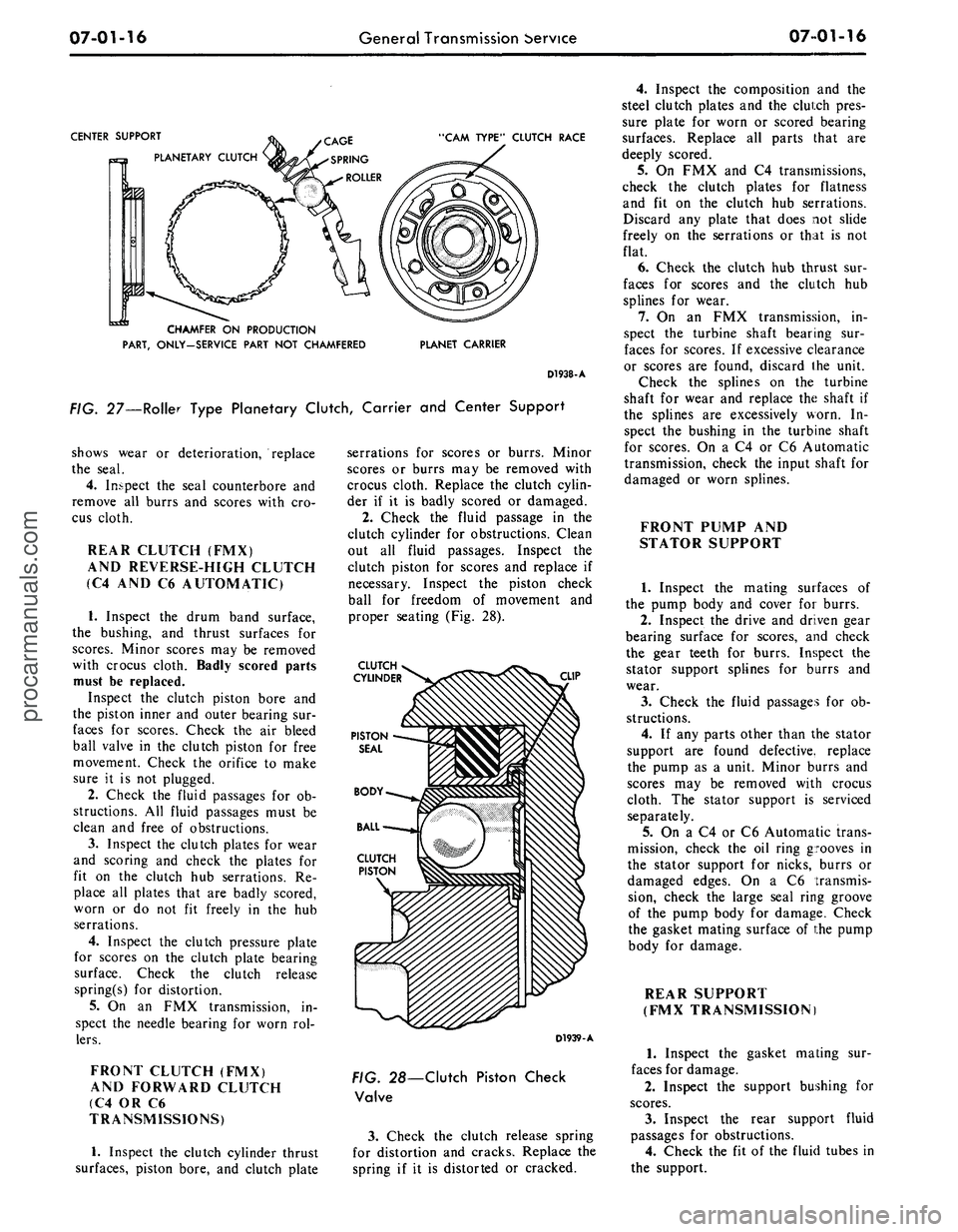
07-01-16
General Transmission bervice
07-01-16
CENTER SUPPORT
PLANETARY CLUTCH
"CAM TYPE" CLUTCH RACE
CHAMFER ON PRODUCTION
PART, ONLY-SERVICE PART NOT CHAMFERED
PLANET CARRIER
D1938-A
FIG. 27—Roller Type Planetary Clutch, Carrier and Center Support
shows wear or deterioration, replace
the seal.
4.
Inspect the seal counterbore and
remove all burrs and scores with cro-
cus cloth.
REAR CLUTCH (FMX)
AND REVERSE-HIGH CLUTCH
(C4 AND C6 AUTOMATIC)
1.
Inspect the drum band surface,
the bushing, and thrust surfaces for
scores. Minor scores may be removed
with crocus cloth. Badly scored parts
must be replaced.
Inspect the clutch piston bore and
the piston inner and outer bearing sur-
faces for scores. Check the air bleed
ball valve in the clutch piston for free
movement. Check the orifice to make
sure it is not plugged.
2.
Check the fluid passages for ob-
structions. All fluid passages must be
clean and free of obstructions.
3.
Inspect the clutch plates for wear
and scoring and check the plates for
fit on the clutch hub serrations. Re-
place all plates that are badly scored,
worn or do not fit freely in the hub
serrations.
4.
Inspect the clutch pressure plate
for scores on the clutch plate bearing
surface. Check the clutch release
spring(s) for distortion.
5.
On an FMX transmission, in-
spect the needle bearing for worn rol-
lers.
FRONT CLUTCH (FMX)
AND FORWARD CLUTCH
(C4 OR C6
TRANSMISSIONS)
1.
Inspect the clutch cylinder thrust
surfaces, piston bore, and clutch plate
serrations for scores or burrs. Minor
scores or burrs may be removed with
crocus cloth. Replace the clutch cylin-
der if it is badly scored or damaged.
2.
Check the fluid passage in the
clutch cylinder for obstructions. Clean
out all fluid passages. Inspect the
clutch piston for scores and replace if
necessary. Inspect the piston check
ball for freedom of movement and
proper seating (Fig. 28).
CLUTCH
CYLINDER
PISTON
SEAL
CLIP
D1939-A
. 28—Clutch Piston Check
Valve
3.
Check the clutch release spring
for distortion and cracks. Replace the
spring if it is distorted or cracked.
4.
Inspect the composition and the
steel clutch plates and the clutch pres-
sure plate for worn or scored bearing
surfaces. Replace all parts that are
deeply scored.
5.
On FMX and C4 transmissions,
check the clutch plates for flatness
and fit on the clutch hub serrations.
Discard any plate that does not slide
freely on the serrations or that is not
flat.
6. Check the clutch hub thrust sur-
faces for scores and the clutch hub
splines for wear.
7.
On an FMX transmission, in-
spect the turbine shaft bearing sur-
faces for scores. If excessive clearance
or scores are found, discard the unit.
Check the splines on the turbine
shaft for wear and replace the shaft if
the splines are excessively worn. In-
spect the bushing in the turbine shaft
for scores. On a C4 or C6 Automatic
transmission, check the input shaft for
damaged or worn splines.
FRONT PUMP AND
STATOR SUPPORT
1.
Inspect the mating surfaces of
the pump body and cover for burrs.
2.
Inspect the drive and driven gear
bearing surface for scores, and check
the gear teeth for burrs. Inspect the
stator support splines for burrs and
wear.
3.
Check the fluid passages for ob-
structions.
4.
If any parts other than the stator
support are found defective, replace
the pump as a unit. Minor burrs and
scores may be removed with crocus
cloth. The stator support is serviced
separately.
5.
On a C4 or C6 Automatic trans-
mission, check the oil ring grooves in
the stator support for nicks, burrs or
damaged edges. On a C6 transmis-
sion, check the large seal ring groove
of the pump body for damage. Check
the gasket mating surface of the pump
body for damage.
REAR SUPPORT
(FMX TRANSMISSION)
1.
Inspect the gasket mating sur-
faces for damage.
2.
Inspect the support bushing for
scores.
3.
Inspect the rear support fluid
passages for obstructions.
4.
Check the fit of the fluid tubes in
the support.procarmanuals.com
Page 308 of 413
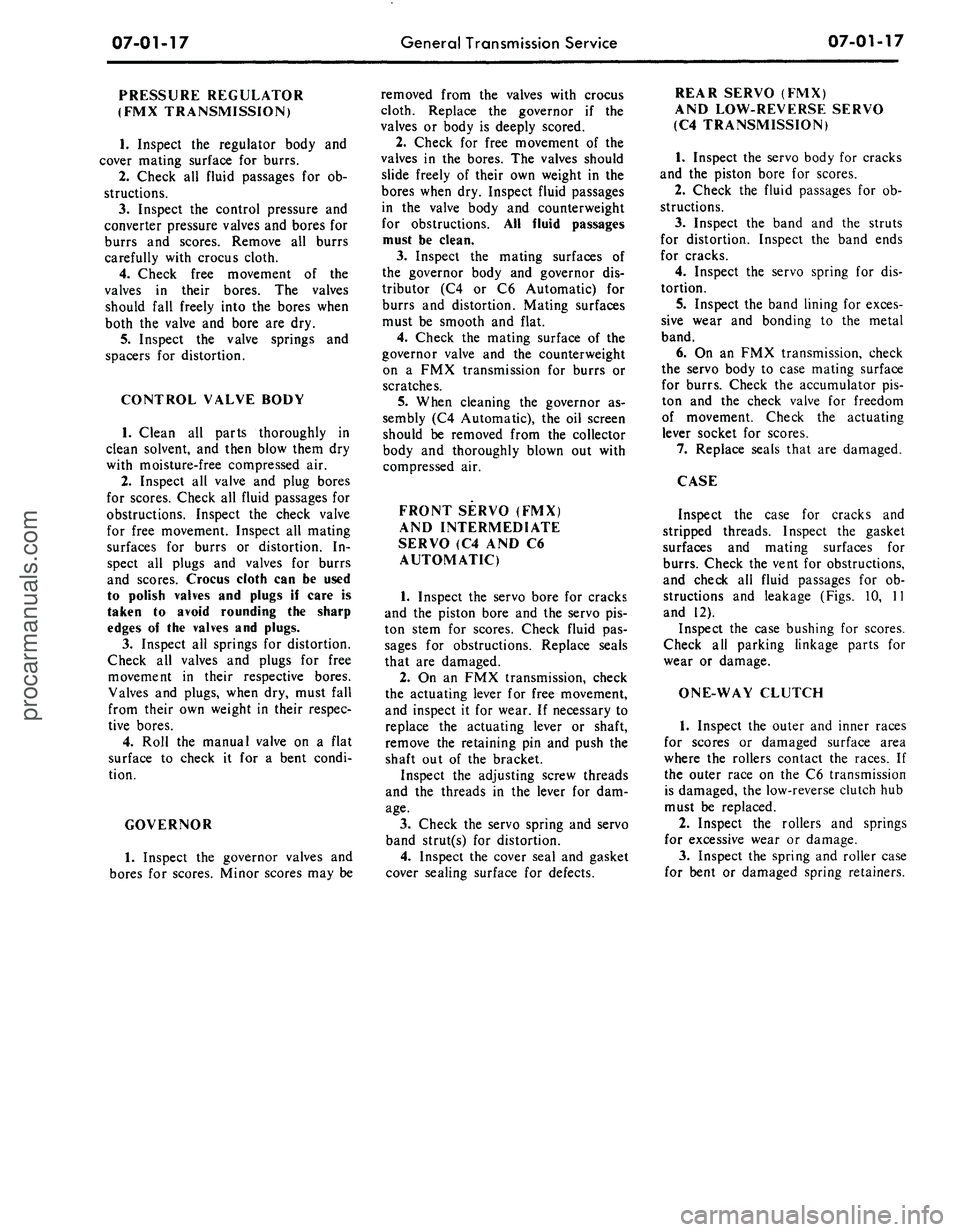
07-01-17
General Transmission Service
07-01-17
PRESSURE REGULATOR
(FMX TRANSMISSION)
1.
Inspect the regulator body and
cover mating surface for burrs.
2.
Check all fluid passages for ob-
structions.
3.
Inspect the control pressure and
converter pressure valves and bores for
burrs and scores. Remove all burrs
carefully with crocus cloth.
4.
Check free movement of the
valves in their bores. The valves
should fall freely into the bores when
both the valve and bore are dry.
5.
Inspect the valve springs and
spacers for distortion.
CONTROL VALVE BODY
1.
Clean all parts thoroughly in
clean solvent, and then blow them dry
with moisture-free compressed air.
2.
Inspect all valve and plug bores
for scores. Check all fluid passages for
obstructions. Inspect the check valve
for free movement. Inspect all mating
surfaces for burrs or distortion. In-
spect all plugs and valves for burrs
and scores. Crocus cloth can be used
to polish valves and plugs if care is
taken to avoid rounding the sharp
edges of the valves and plugs.
3.
Inspect all springs for distortion.
Check all valves and plugs for free
movement in their respective bores.
Valves and plugs, when dry, must fall
from their own weight in their respec-
tive bores.
4.
Roll the manual valve on a flat
surface to check it for a bent condi-
tion.
GOVERNOR
1.
Inspect the governor valves and
bores for scores. Minor scores may be
removed from the valves with crocus
cloth. Replace the governor if the
valves or body is deeply scored.
2.
Check for free movement of the
valves in the bores. The valves should
slide freely of their own weight in the
bores when dry. Inspect fluid passages
in the valve body and counterweight
for obstructions. All fluid passages
must be clean.
3.
Inspect the mating surfaces of
the governor body and governor dis-
tributor (C4 or C6 Automatic) for
burrs and distortion. Mating surfaces
must be smooth and flat.
4.
Check the mating surface of the
governor valve and the counterweight
on a FMX transmission for burrs or
scratches.
5.
When cleaning the governor as-
sembly (C4 Automatic), the oil screen
should be removed from the collector
body and thoroughly blown out with
compressed air.
FRONT SERVO (FMX)
AND INTERMEDIATE
SERVO (C4 AND C6
AUTOMATIC)
1.
Inspect the servo bore for cracks
and the piston bore and the servo pis-
ton stem for scores. Check fluid pas-
sages for obstructions. Replace seals
that are damaged.
2.
On an FMX transmission, check
the actuating lever for free movement,
and inspect it for wear. If necessary to
replace the actuating lever or shaft,
remove the retaining pin and push the
shaft out of the bracket.
Inspect the adjusting screw threads
and the threads in the lever for dam-
age.
3.
Check the servo spring and servo
band strut(s) for distortion.
4.
Inspect the cover seal and gasket
cover sealing surface for defects.
REAR SERVO (FMX)
AND LOW-REVERSE SERVO
(C4 TRANSMISSION)
1.
Inspect the servo body for cracks
and the piston bore for scores.
2.
Check the fluid passages for ob-
structions.
3.
Inspect the band and the struts
for distortion. Inspect the band ends
for cracks.
4.
Inspect the servo spring for dis-
tortion.
5.
Inspect the band lining for exces-
sive wear and bonding to the metal
band.
6. On an FMX transmission, check
the servo body to case mating surface
for burrs. Check the accumulator pis-
ton and the check valve for freedom
of movement. Check the actuating
lever socket for scores.
7.
Replace seals that are damaged.
CASE
Inspect the case for cracks and
stripped threads. Inspect the gasket
surfaces and mating surfaces for
burrs.
Check the vent for obstructions,
and check all fluid passages for ob-
structions and leakage (Figs. 10, 11
and 12).
Inspect the case bushing for scores.
Check all parking linkage parts for
wear or damage.
ONE-WAY CLUTCH
1.
Inspect the outer and inner races
for scores or damaged surface area
where the rollers contact the races. If
the outer race on the C6 transmission
is damaged, the low-reverse clutch hub
must be replaced.
2.
Inspect the rollers and springs
for excessive wear or damage.
3.
Inspect the spring and roller case
for bent or damaged spring retainers.procarmanuals.com
Page 309 of 413
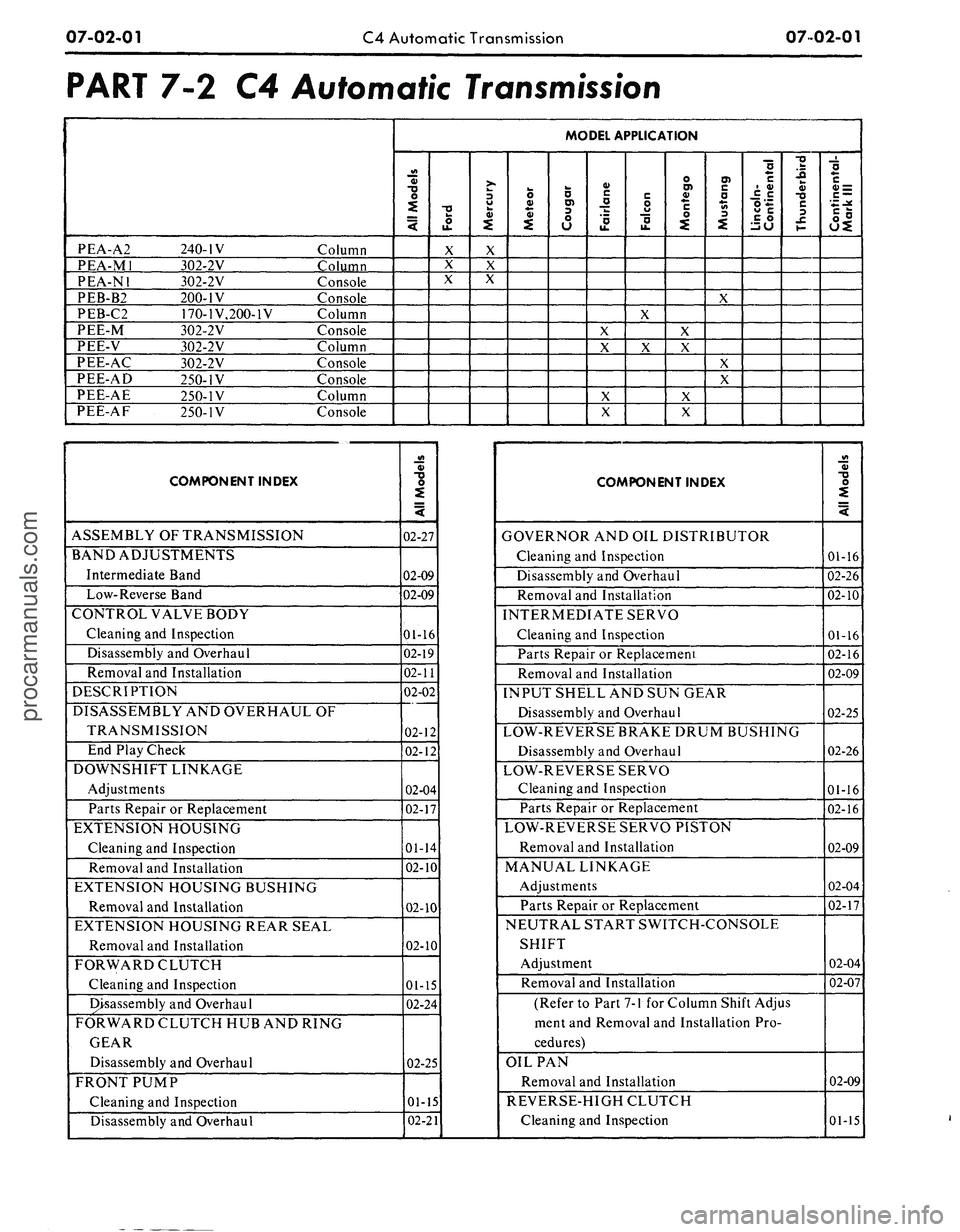
07-02^01
C4 Automatic Transmission
0702-01
PART 7-2 C4 Automatic
Transmission
PEA-A2 240-1V Column
PEA-MI 302-2V Column
PEA-N1 3O2-2V Console
PEB-B2 200-1V Console
PEB-C2 17O-1V,2OO-1V Column
PEE-M 302-2V Console
PEE-V 302-2V Column
PEE-AC 302-2V Console
PEE-AD 250-1V Console
PEE-AE 250-1V Column
PEE-AF 250-1V Console
MODEL APPLICATION
All
Models
Ford
X
X
X
Mercury
X
X
X
Meteor
Cougar
Fairiane
X
X
X
X
Falcon
X
X
Montego
X
X
X
X
Mustang
X
X
X
Lincoln-
Continental
Thunderbird
Continental-
Mark
III
COMPONENT INDEX
ASSEMBLY OF TRANSMISSION
BAND ADJUSTMENTS
Intermediate Band
Low-Reverse Band
CONTROL VALVE BODY
Cleaning and Inspection
Disassembly and Overhaul
Removal and Installation
DESCRIPTION
DISASSEMBLY AND OVERHAUL OF
TRANSMISSION
End Play Check
DOWNSHIFT LINKAGE
Adjustments
Parts Repair or Replacement
EXTENSION HOUSING
Cleaning and Inspection
Removal and Installation
EXTENSION HOUSING BUSHING
Removal and Installation
EXTENSION HOUSING REAR SEAL
Removal and Installation
FORWARD CLUTCH
Cleaning and Inspection
Disassembly and Overhaul
FORWARD CLUTCH HUB AND RING
GEAR
Disassembly and Overhaul
FRONT PUMP
Cleaning and Inspection
Disassembly and Overhaul
All
Models
02-27
02-09
02-09
01-16
02-19
02-11
02-02
02-12
02-12
02-04
02-17
01-14
02-10
02-10
02-10
01-15
02-24
02-25
01-15
02-21
COMPONENT INDEX
GOVERNOR AND OIL DISTRIBUTOR
Cleaning and Inspection
Disassembly and Overhaul
Removal and Installation
INTERMEDIATE SERVO
Cleaning and Inspection
Parts Repair or Replacement
Removal and Installation
INPUT SHELL AND SUN GEAR
Disassembly and Overhaul
LOW-REVERSE BRAKE DRUM BUSHING
Disassembly and Overhaul
LOW-REVERSE SERVO
Cleaning and Inspection
Parts Repair or Replacement
LOW-REVERSE SERVO PISTON
Removal and Installation
MANUAL LINKAGE
Adjustments
Parts Repair or Replacement
NEUTRAL START SWITCH-CONSOLE
SHIFT
Adjustment
Removal and Installation
(Refer to Part 7-1 for Column Shift Adjus
ment and Removal and Installation Pro-
cedures)
OIL PAN
Removal and Installation
REVERSE-HIGH CLUTCH
Cleaning and Inspection
All
Models
01-16
02-26
02-10
01-16
02-16
02-09
02-25
02-26
01-16
02-16
02-09
02-04
02-17
02-04
02-07
02-09
01-15
procarmanuals.com
Page 310 of 413
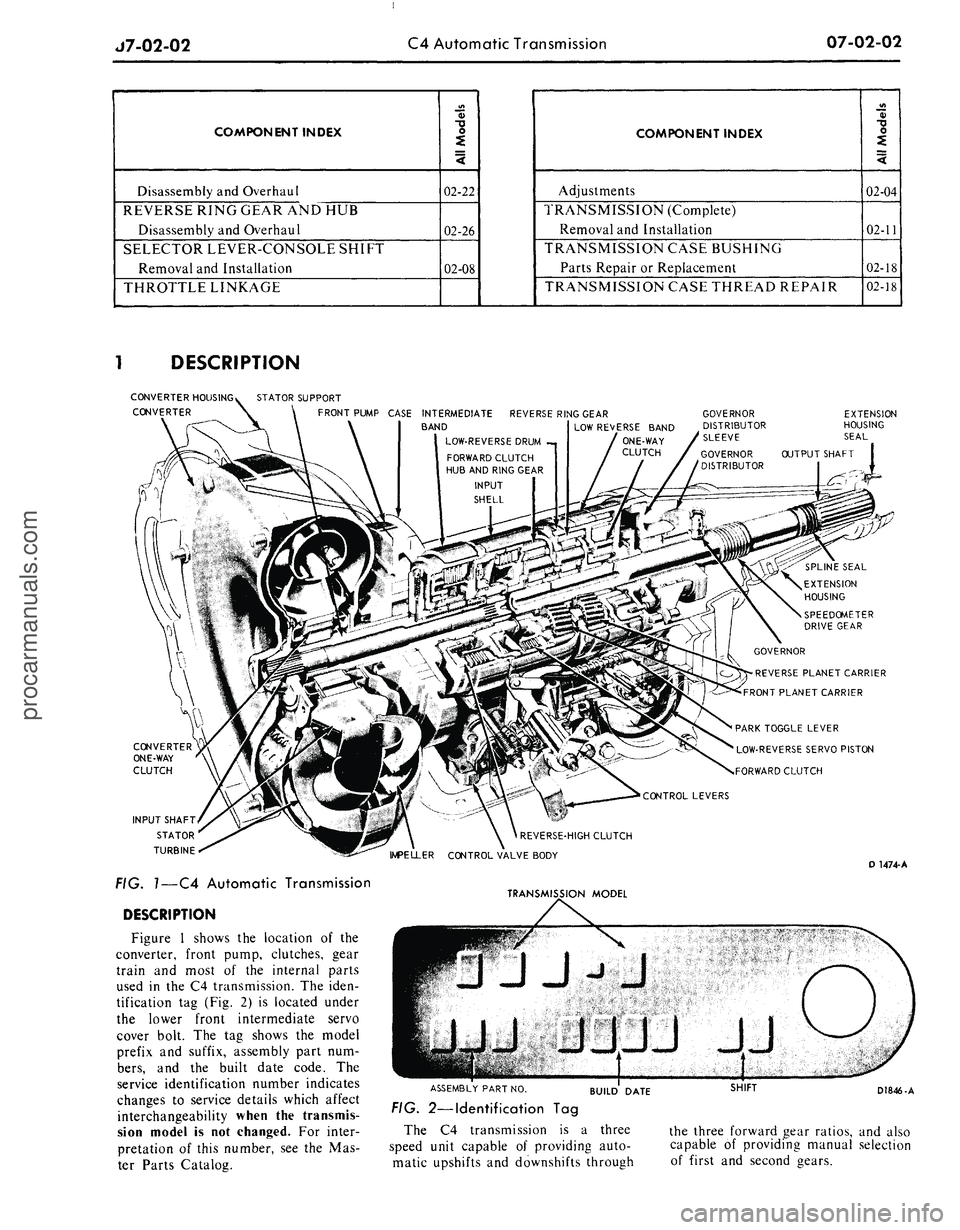
J7-02-02
C4 Automatic Transmission
07-02-02
COMPONENT INDEX
Disassembly and Overhaul
REVERSE RING GEAR AND HUB
Disassembly and Overhaul
SELECTOR LEVER-CONSOLE SHIFT
Removal and Installation
THROTTLE LINKAGE
All
Models
02-22
02-26
02-08
COMPONENT INDEX
Adjustments
TRANSMISSION (Complete)
Removal and Installation
TRANSMISSION CASE BUSHING
Parts Repair or Replacement
TRANSMISSION CASE THREAD REPAIR
All
Models
02-04
02-11
02-18
02-18
DESCRIPTION
CONVERTER HOUSING,
CONVERTER
STATOR SUPPORT
FRONT PUMP CASE
INTERMEDIATE
BAND
LOW-REVERSE DRUM
-,
FORWARD CLUTCH
HUB AND RING GEAR
INPUT
SHELL
REVERSE RING GEAR
LOW REVERSE BAND
ONE-WAY
CLUTCH
GOVERNOR
DISTRIBUTOR
SLEEVE
GOVERNOR
DISTRIBUTOR
SPLINE SEAL
EXTENSION
HOUSING
SPEEDOMETER
DRIVE GEAR
GOVERNOR
REVERSE PLANET CARRIER
FRONT PLANET CARRIER
PARK TOGGLE LEVER
LOW-REVERSE SERVO PISTON
FORWARD CLUTCH
CONTROL LEVERS
FIG.
1—C4
Automatic Transmission
DESCRIPTION
Figure
1
shows
the
location
of the
converter, front pump, clutches, gear
train
and
most
of the
internal parts
used
in
the C4 transmission. The iden-
tification
tag
(Fig.
2) is
located under
the lower front intermediate servo
cover bolt.
The tag
shows
the
model
prefix
and
suffix, assembly part num-
bers,
and the
built date code.
The
service identification number indicates
changes
to
service details which affect
interchangeability when
the
transmis-
sion model
is not
changed.
For
inter-
pretation
of
this number, see the Mas-
ter Parts Catalog.
REVERSE-HIGH CLUTCH
IMPELLER CONTROL VALVE BODY
TRANSMISSION MODEL
D 1474-A
ASSEMBLY PART NO. BUILD DATE
FIG.
2—Identification
Tag
The
C4
transmission
is a
three
speed unit capable
of
providing auto-
matic upshifts
and
downshifts through
SHIFT
D1846-A
the three forward gear ratios,
and
also
capable
of
providing manual selection
of first
and
second gears.
procarmanuals.com